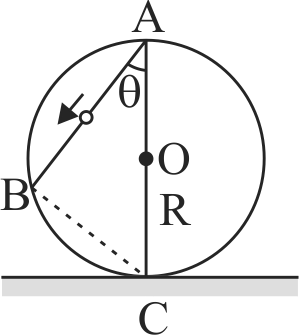362332 A car is moving towards check post with velocity of \(54\,\,km{h^{ - 1}}\). When the car is at a distance of 400 \(m\) from the check post, the driver applies brakes which causes a deceleration of \(0.3 {~ms}^{-2}\). Find the distance of car from the check post for 2 minutes after applying the brakes.
362334 A particle start from rest with a velocity of \(10\,m{\rm{/}}s\) and moves with a constant acceleration till the velocity increases to \(100\,m{\rm{/}}s\). At an instant the acceleration is simultaneously reversed, what will be the velocity of the particle when it comes back to the starting point?
362332 A car is moving towards check post with velocity of \(54\,\,km{h^{ - 1}}\). When the car is at a distance of 400 \(m\) from the check post, the driver applies brakes which causes a deceleration of \(0.3 {~ms}^{-2}\). Find the distance of car from the check post for 2 minutes after applying the brakes.
362334 A particle start from rest with a velocity of \(10\,m{\rm{/}}s\) and moves with a constant acceleration till the velocity increases to \(100\,m{\rm{/}}s\). At an instant the acceleration is simultaneously reversed, what will be the velocity of the particle when it comes back to the starting point?
362332 A car is moving towards check post with velocity of \(54\,\,km{h^{ - 1}}\). When the car is at a distance of 400 \(m\) from the check post, the driver applies brakes which causes a deceleration of \(0.3 {~ms}^{-2}\). Find the distance of car from the check post for 2 minutes after applying the brakes.
362334 A particle start from rest with a velocity of \(10\,m{\rm{/}}s\) and moves with a constant acceleration till the velocity increases to \(100\,m{\rm{/}}s\). At an instant the acceleration is simultaneously reversed, what will be the velocity of the particle when it comes back to the starting point?
362332 A car is moving towards check post with velocity of \(54\,\,km{h^{ - 1}}\). When the car is at a distance of 400 \(m\) from the check post, the driver applies brakes which causes a deceleration of \(0.3 {~ms}^{-2}\). Find the distance of car from the check post for 2 minutes after applying the brakes.
362334 A particle start from rest with a velocity of \(10\,m{\rm{/}}s\) and moves with a constant acceleration till the velocity increases to \(100\,m{\rm{/}}s\). At an instant the acceleration is simultaneously reversed, what will be the velocity of the particle when it comes back to the starting point?
